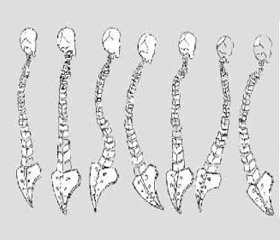Журнал «Травма» Том 16, №4, 2015
Вернуться к номеру
Peculiarities muscle imbalance in patients with Scheuermann’s disease with different variants of the spine sagittal contour
Авторы: Kolesnichenko V.A., Dniprovska A.V., Fischenko V.A.
Рубрики: Травматология и ортопедия
Разделы: Клинические исследования
Версия для печати
Background.
Change the sagittal contour of the spine accompanied by the development of muscle imbalance with the weakening of the extensor muscles of the lumbar-pelvic region, which can lead to spinal-pelvic imbalance and potentiating the progression of the latter. In addition, the study of the muscles interaction that stabilize the spine and hip joints when developing deformations of the spine, is the basis of selective corrective physiotherapy aimed at restoring movement patterns of these patients
Material and methods.
Group A - patients with the classic form of the disease with Scheuermann kyphosis of the thoracic spine (n = 50); group B - patients with atypical variant of the disease with lumbar spine and flattening the physiological curves of the spine (n = 50). All male patients aged 18-24 years (mean age 20,6 ± 0,3 years).
Studied: 1) the mobility of the thoracic fnd lumbar spine in flexion with Schober’s method, range of motion in the hip joints; 2) tone, strength and endurance of the various muscle groups of the trunk and lower extremities; 3) the intensity of low back pain on a visual analog scale (VAS); disability index (ODI) as a result of back pain with Oswestry Disability Questionnaire, version 2.0; the level of anxiety and fear associated with the anticipation of pain (PASS), on a scale of Pain and Anxiety Symptoms Scale - 20; 4) the thoracic kyphosis and the lumbar lordosis magnitude was measured in the lateral view thoracic and lumbar spondylograms standing by method Cobb; 5) bioelectric activity of the lumbar part of the muscles erector spinae left and right .
During the statistical research we used the t-criteria (Student’s method).
Results.
Clinical studies in patients with the classic form of the Sheurmann’s disease revealed a significant restriction of mobility of the thoracic and lumbar spine, and the spine in general, the results of functional tests Schober and 'fingers - floor "respectively. There was quite marked limitation of the flexion amplitude with the conservation of the extension amplitude of the hip joints. The test results showed a strong muscle tone muscle tension - extensors of the spine and hips, which is typical for the classical form of the Sheurmann’s disease . Also found a decrease in strength and endurance of muscles - flexors and extensors of the spine and hips It was found that patients with the classic form of the Sheurmann’s disease determined sagittal contour of the spine in the form of a C-shaped deformation of the breast hyperkyphosis not offset by corresponding lumbar antedeformation.
Orthopaedic status of patients with atypical variant of the Sheurmann’s disease also had some differences. The most significant of them turned out to be statistically significant mobility of the spine as a whole (as measured by "fingers - floor"); p <0.001. Less significant were the differences in the amplitude of the extension of the hip joints (p <0.05). Study of various muscle groups of the trunk and lower extremities in patients with Sheurmann’s disease atypical variants allowed to establish a decrease of almost all functional properties studied.
When perform the surface EMG of the lumbar part of the muscles erector spinae standing there is a significant asymmetry parameters of bioelectrical activity of the right and left parts of the muscles in both groups.
Conclusion.
Clinical and radiographic manifestations of the the Sheurmann’s disease both forms accompanied by changes of the spine sagittal contour to the development of spinal and pelvic muscle imbalance. Changing the tone, strength and endurance of muscles - flexors and extensors of the trunk and lower extremities accompanied by a breach coactivation these muscle groups with the developmental of functional, and subsequently - supporting organic contractures of joints, change in the conditions of the stabilization of the latter and limited functionality of the locomotor system.

